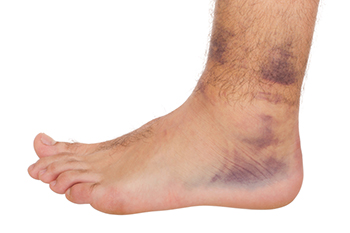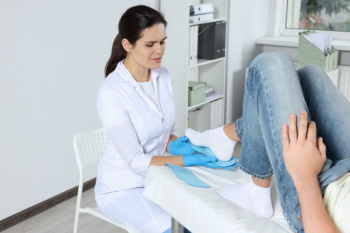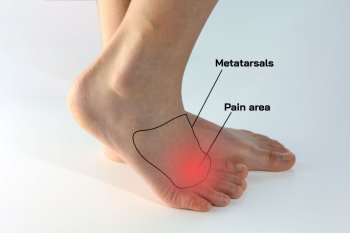Connect With Us
Blog

An ankle sprain occurs when the ligaments on the outside of the ankle are stretched or torn due to sudden twisting or rolling of the foot. Symptoms include swollen painful tissue, bruising, and difficulty walking. Grade 1 sprains involve mild stretching of the ligament with slight tenderness. Grade 2 sprains include partial tearing with noticeable swelling and reduced movement. Grade 3 sprains involve a complete tear with significant instability and severe pain. A podiatrist can diagnose the severity, provide proper treatment, and create a targeted exercise plan to restore strength and stability. Prompt care reduces the risk of long term problems. If you have sprained your ankle, it is suggested that you promptly schedule an appointment with a podiatrist who can provide an accurate diagnosis and treatment.
Ankle sprains are common but need immediate attention. If you need your feet checked, contact one of our doctors from New Jersey and New York. Our doctors can provide the care you need to keep you pain-free and on your feet.
How Does an Ankle Sprain Occur?
Ankle sprains take place when the ligaments in your ankle are torn or stretched beyond their limits. There are multiple ways that the ankle can become injured, including twisting or rolling over onto your ankle, putting undue stress on it, or causing trauma to the ankle itself.
What Are the Symptoms?
- Mild to moderate bruising
- Limited mobility
- Swelling
- Discoloration of the skin (depending on severity)
Preventing a Sprain
- Wearing appropriate shoes for the occasion
- Stretching before exercises and sports
- Knowing your limits
Treatment of a Sprain
Treatment of a sprain depends on the severity. Many times, people are told to rest and remain off their feet completely, while others are given an air cast. If the sprain is very severe, surgery may be required.
If you have suffered an ankle sprain previously, you may want to consider additional support such as a brace and regular exercises to strengthen the ankle.
If you have any questions please feel free to contact our offices located in Little Silver, NJ and New York, NY . We offer the newest diagnostic tools and technology to treat your foot and ankle needs.

Wearing the correct shoe size is essential for maintaining foot health and comfort. Shoes should fit securely around the heel and toes without tightness or slipping. It is important to measure your feet regularly, try on both shoes, and shop in the afternoon when feet are slightly swollen for the best fit. Wearing the wrong size can lead to foot conditions such as blisters, bunions, corns, calluses, and even chronic pain. A podiatrist can assess your foot structure, recommend proper footwear, and provide custom orthotics to enhance comfort and prevent injury. If you have foot pain from wearing shoes that do not fit correctly, it is suggested that you consult a podiatrist who can treat various foot conditions, and offer you additional tips on how to buy shoes that fit properly.
Getting the right shoe size is an important part of proper foot health. Seek the assistance of one of our doctors from New Jersey and New York. Our doctors will provide the care you need to keep you pain-free and on your feet.
Getting the Right Shoe Size
There are many people who wear shoes that are the incorrect size, negatively affecting their feet and posture. Selecting the right shoes is not a difficult process, so long as you keep several things in mind when it comes to choosing the right pair.
- When visiting the shoe store, use the tools available to measure your foot.
- Be sure there is ‘wiggle room’. There should be about an inch between your toes and the tip of your shoes.
- Do not always assume you are the same size, as manufacturers run differently.
- Purchase shoes later in the day, as your feet swell as the day progresses.
- If a shoe is not comfortable, it is not suitable. Most shoes can’t be ‘broken in’, and comfort should be the ultimate goal when it comes to choosing the right pair of shoes
As our feet hold our body weight and keep us moving, it is important to treat them right. Picking the right pair of shoes can provide your feet comfort and mobility without pain.
If you have any questions, please feel free to contact our offices located in Little Silver, NJ and New York, NY . We offer the newest diagnostic and treatment technologies for all your foot care needs.

Morton’s neuroma is a painful condition that affects the nerve between the third and fourth toes, often caused by thickening of the nerve tissue. Symptoms include sharp, burning pain that shoots between the toes, tingling, or the feeling of standing on a pebble. Common causes include wearing tight or narrow shoes that compress the toes, having flat feet, or existing conditions such as bunions that alter foot alignment. A podiatrist can diagnose Morton’s neuroma through an examination and imaging tests, then provide treatment options, such as footwear modifications, custom orthotics, or anti-inflammatory therapy to relieve pressure and pain. If you have pain in this part of your foot, it is suggested that you consult a podiatrist who can accurately diagnose and treat the problem.
Morton’s neuroma is a very uncomfortable condition to live with. If you think you have Morton’s neuroma, contact one of our doctors of New Jersey and New York. Our doctors will attend to all of your foot care needs and answer any of your related questions.
Morton’s Neuroma
Morton's neuroma is a painful foot condition that commonly affects the areas between the second and third or third and fourth toe, although other areas of the foot are also susceptible. Morton’s neuroma is caused by an inflamed nerve in the foot that is being squeezed and aggravated by surrounding bones.
What Increases the Chances of Having Morton’s Neuroma?
- Ill-fitting high heels or shoes that add pressure to the toe or foot
- Jogging, running or any sport that involves constant impact to the foot
- Flat feet, bunions, and any other foot deformities
Morton’s neuroma is a very treatable condition. Orthotics and shoe inserts can often be used to alleviate the pain on the forefront of the feet. In more severe cases, corticosteroids can also be prescribed. In order to figure out the best treatment for your neuroma, it’s recommended to seek the care of a podiatrist who can diagnose your condition and provide different treatment options.
If you have any questions, please feel free to contact our offices located in Little Silver, NJ and New York, NY . We offer the newest diagnostic and treatment technologies for all your foot care needs.

